Have you ever come across people who believe that blogging isn’t relevant anymore?
It’s understandable since a lot of marketing experts are adding podcasting and video to their marketing mix, which is good. Some believe that blogging takes time and people don’t want to spend their time scrolling through the lengthy articles. If you understand content marketing or you work in the digital marketing space, chances are, you might have thought as well that whether or not you should focus on blogging. It’s a debate that we hear at some point in the digital marketing world.
It’s also true that such opinions drive our decision-making process somehow. So we’ve decided to talk about blogging from a different perspective so that many of you who have personal brands, startups, and companies look into it.
If you believe that blogging isn’t essential to your content marketing because you’re already juggling videos, live streaming, infographics, and pictures, then keep reading this article.
It’s a rather interesting discussion that whether or not blogging is essential to content marketing. There is a fine line between not being able to blog and don’t want to blog, no pun intended. Here’s an interesting thing you’d agree with: if we look up “how to bake a cake” in Google, there are two hundred thirty-two million results that come up. Some of us open a few articles and go through the recipe and ingredients before baking a cake, but we still question the relevance of blogging in today’s world.
Before we dig deeper into the reasons why blogging is essential to content marketing strategy, let’s take a look at the key elements of blogging that will set the tone for any blog:
Blog Type: It’s important to know the type of blog you’re starting out. There are various types of blogs such as official blogs which companies use to communicate with the audience, niche blogs that are subject-oriented, and personal blogs that revolve around specific persons.
Niche Selection: A niche is a category that a blog falls in. It defines the type of your blog so that it becomes easier for you as well as the audience to understand your content.
Area of Interest: A blog without being passionate about the topic is incomplete. It may not seem true in the beginning, but if you aren’t excited about your niche, you’ll quit the blog at some point. So always look at the area of interest while starting your blog.
Writing Skill: Writing may not be a nightmare for you, but there are millions of people out there who are afraid to put out a paragraph because they think their writing sucks. It’s essential to improve your writing skill to blog successfully.
Target Audience: Target audience is a crowd that you want to reach out through your blog’s content. It’s necessary to understand the type of audience you want to reach to get the fruitful results. A blog’s content strategy plays a vital role in attracting the target audience.
What’s a Content Marketing Strategy?
I’d like to shed some light on the content marketing strategy because if you have a hard time understanding the fundamental idea of a content marketing strategy, everything you’d read further might be pointless.
A content marketing strategy is a well-structured content plan designed to create and put out content that is in-line with the brand’s marketing agenda.
A 3-Step Process of Making a Content Marketing Strategy:
- Identifying the Audience
The audience identification is the stepping stone of making a content marketing strategy successful. If a brand doesn’t find its target audience, then it’d be impossible to reach out and talk to them. Figuring out who needs your product makes you more prepared for the challenges to come.
Furthermore, the better you understand your audience, the easier it becomes to solve their issues through your products and services. A well-crafted content marketing strategy works as a bridge between the brand and the client. Due diligence is certainly required to identify the right audience for your business. Not only will it save your resources, but it will also save your time.
- Creating a Content Plan
Once the audience has been identified, the next job is to create a content plan. The basic idea of creating a content plan is to feed your audience with high-quality content that makes their lives easier. Content marketing isn’t just about creating content to sell the products. Instead, it’s a connection-building process between a business and prospective customers.
Brands who understand content marketing, they don’t only create sales and marketing content to increase their sales and go after the transaction. Instead, they try to develop a relationship with the audience, which helps them build trust between them. At some point, some of those prospective customers turn into paying customers because of the trust, loyalty, and relationship.
So pay close attention to creating content that helps your audience rather than focusing on the salesy content that is intended to initiate the purchase.
- Distributing the Content
Content marketing isn’t just about creating content that helps the audience or educates your prospective clients on a topic. The content distribution is vital to the whole process of content marketing. If you don’t have a plan on how to distribute your content, then make one before it’s too late. Distribution of content means how you put out your content on various platforms.
It doesn’t have to be scary at all. All you need is to sort out that how you would write content to publish on your blog. Since you can create various types of content such as articles, videos, podcasts, and infographics so you have to be well aware of your strengths. Content curation is a concept of stacking up already created content and present it to your audience.
Once you have finished creating your content, the next up is the distribution. ContentStudio is a social media management tool that helps you in content distribution. Not only does it share and schedule your social media posts, but it also posts content to blogging platforms such as WordPress, Medium, and Tumblr.
Let’s focus on the core point now. I’m going to share the secrets that would change your perception about blogging. It has fundamentally changed the marketing priorities of many companies out there. You’ll understand why so many companies have official blogs and why they put out content on a regular basis. Here’s the answer to all of that:
5 Reasons Why Blogging is Essential to Your Content Marketing Strategy
- Organic Traffic and SEO Growth
Most of the bloggers know the importance of publishing content because that’s what they do for a living. The irony is that most companies don’t know that why they should be writing and publishing content on their blogs. There might be a handful of reasons why a blog is essential to your business, but the SEO is one of the top ones.
If you aren’t familiar with the term “SEO” then let me explain it. It’s the acronym for Search Engine Optimization. It’s a process of preparing a website to appear in the search engine results for specific keywords. The whole idea of the SEO is to dominate the niche and perform better in search engine ranking.
Blogging is essentially a vital tool for the SEO. There are, however, many different avenues of the SEO such as inbound links, images size, page loading speed, keywords selection, keywords density, well-written content, search engine ranking page, meta tags, off-page SEO, and on-page SEO. In other words, blogging becomes the backbone to any SEO campaign. Whenever SEO experts start off with their SEO campaigns, the first thing they require is the content that must be written around the keywords and the topics of the interest.
When we design a content marketing strategy, we look at the different forms of content such as articles, videos, infographics, and podcasts. We can add multiple content types in our marketing mix, but written content is vital to the SEO, for example, you’d need to write a good copy for your website pages, landing pages, and social media posts to naturally inject the keywords as well as solve the visitors’ problem. Moreover, you’d be required to publish blog posts on a regular basis to stay relevant and keep pumping out fresh content to reach the audience.
If you type in “best social media management tool 2019” in Google just to understand the idea of why blogging is important, you’d notice that almost all of the first-page results are blog posts except for the paid ad at the top.
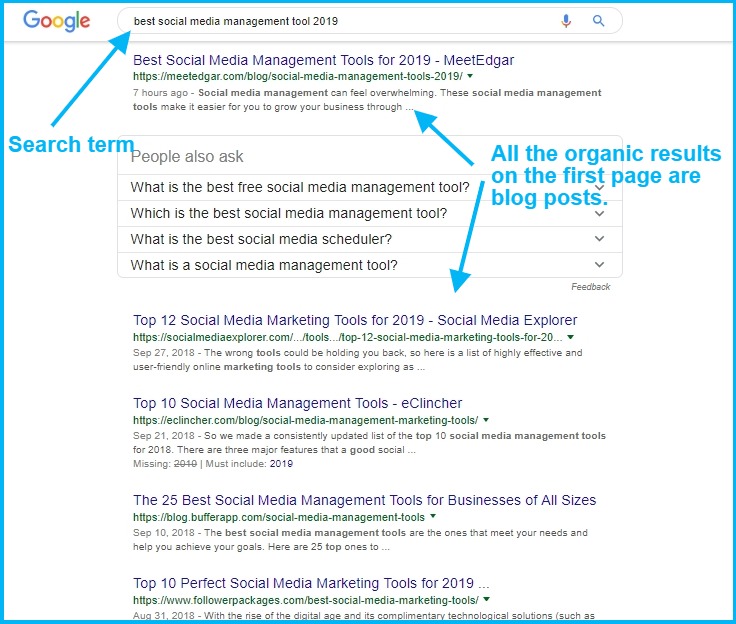
So it shows that a lot of websites and companies are putting out content about social media management tools to dominate the search results. It’s evident that a lot of companies understand the influence of blogging on content marketing, which is why they’re paying attention to it.
- Attracting the New Visitors
The prime reason for blogging is to communicate, share, and educate others on the things that you know, feel, or experience in your life. One can’t write a blog about something he or she doesn’t know very well. When blogging could be a threshold to sending the message across, why not to meet new faces through our blogging?
Blogging does help in getting the attention of the new eyeballs. When you publish a blog post, there are several ways to send your message across and let others know that you’ve something new to share with them. The point is that how we’re going to attract the new visitors to land on our website through blogging.
Here are some suggestions on that:
Write Blog Posts on Relevant Topics
Blogging won’t help unless you do it right. One of the things you could do is start writing blog posts on relevant topics to your prospective clients. Some bloggers and brands look at their specific industries and talk about the hot issues for the time being. It does help, though, but if you develop a consumer-centric content strategy that solves the problems of your audience, you’ll likely to get benefit from your blogging. The easiest way out is that start producing content covering the topics that your audience might be searching for every day and provide them with the solutions.
Look at the Mailchimp Resource Page, they have various types of articles on the resource page to help guide the audience:

Not only do they help their audience, but they are also sticking to their relevant topics as you can see in the screenshot above. Since MailChimp is an email marketing service so they published a blog post titled “How to Build Your Email List” because they know the importance of posting relevant content.
When companies publish relevant content, they end up landing the visitors that could be interested in their content as well as products.
Use Images in the Content
You’d notice pro-bloggers, content marketers, and companies always use images in their content. It’s true that images help content creators portray the message and clarify the narrative, but there are other perks of images too. You could attract the new audience through images.
Since it’s essential to use images in the content from the SEO and content authority standpoints. When you add images whether they’re screenshots, featured image, or shareable image in the content, they’re likely to get traffic from the search engines as well as social media. This way, you could attract the new visitors to check out your website when people find your images through search or visitors stumble upon your content through social media sharing.
You’ll mostly see blog posts with featured images, for example, take a look at this blog post from Grammarly:
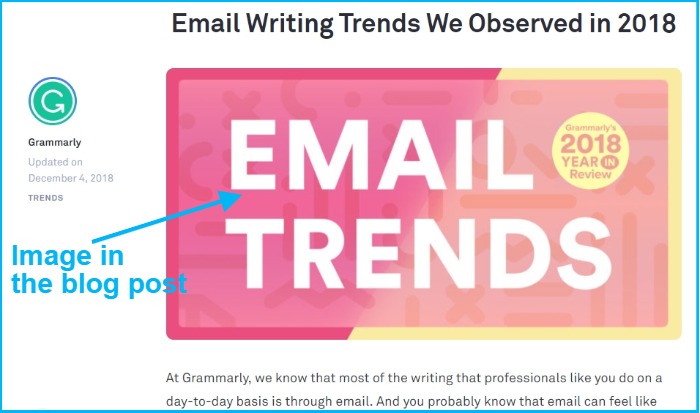
An image does convey a message to the audience as well as it helps the search engine crawlers in understanding the nature of the content. Thus, the majority of SEO experts advise using the content images properly.
SEMrush being one of the leaders in the SEO software genre knows about the importance of images in the content, which is why they always use screenshots and images in their blog post.
Following screenshot is taken from SEMrush’s blog; you can see the screenshots are being used to explain the point:
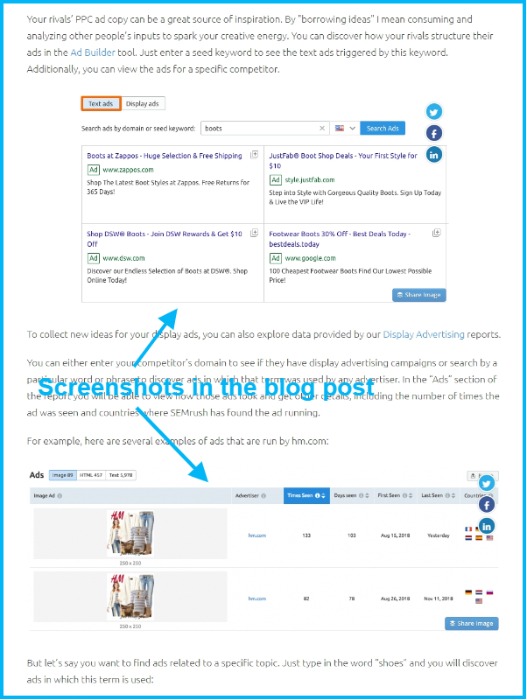
Share Content on Social Media Using Hashtags
One of the ways to attract the new eyeballs on social media is using the right hashtags. A lot of people share content on a regular basis but the lack of attention takes their content nowhere. Despite having a low number of followers, you can always reach out to the bigger audience depending upon various factors such as:
- Hashtag Selection: If you want to start off on the right foot, make sure you know the hashtags that you want to use while sharing your content. The hashtag selection does play a role inSee the screenshot below your social media success. The reason is that you won’t get to reach to the right people if you don’t use the right hashtags.
- Hashtag Popularity: You might not want to use the hashtags that are irrelevant or unpopular. All you need to do is search the hashtag on Twitter, LinkedIn, and Facebook to see the discussions and content around that topic. If the discussion threads are fresh or constantly adding new ones, it means that hashtag is worth trying.
- Posting Time: There isn’t a specific good or bad time to post on social media, but of course, you may not want to post on social media at 1 a.m. when everyone is asleep. You must know when your audience is around so that they could see your social media posts. Therefore, it’s necessary to know what’s the best time for you to post on social media.
So blogging takes your content marketing strategy to a whole new level. It all comes down to the outreach that blogging provides to the blogger. Blogging is the communication of words between a blogger and readers. So undoubtedly blogging opens up so many opportunities for anyone who makes a blog and starts pumping out fresh content.
- Engagement and Relationship Building
Content marketing is a strategy of putting out valuable content for the audience to solve their problems and sometimes drive sales. Often times, we focus so much on these aspects of content marketing that we start to neglect the very reason why content marketing is effective. Content marketing works because there is communication happening between the two parties; the creator and the audience.
People respond and follow our content because we build a relationship with them through our content. Moreover, the relationship wouldn’t be possible if we don’t engage with the audience. How does it feel when you read a blog post and leave a constructive comment underneath it but the author doesn’t respond? It doesn’t feel good, to say the least.
Similarly, the engagement is the essence of relationship building. When we’re putting out content to convey our message and trying to make the audience understand our narrative, it would be rude if we don’t respond to them when they leave their feedback on our content.
If you look at the marketing influencers who’ve built their businesses through content marketing, they always like to engage with the audience. Replying to the comments whether on social media or blog is a great way of engaging with the audience and starting up the conversation.
The team at Copyblogger knows this, which is why they get back to their blog posts to respond to the comments. See the screenshot below:
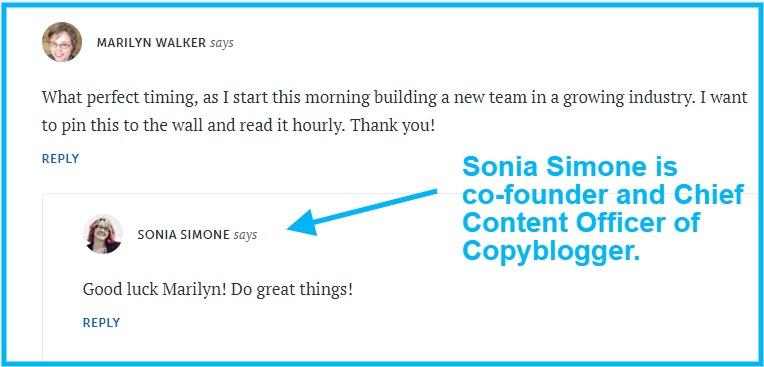
Similarly, Neil Patel, who is a popular blogger, content marketer, and entrepreneur, knows the importance of engagement and responding to the comments. He often tries to reply to every comment he gets on this blog, and he gets a ton of comments on each blog post.
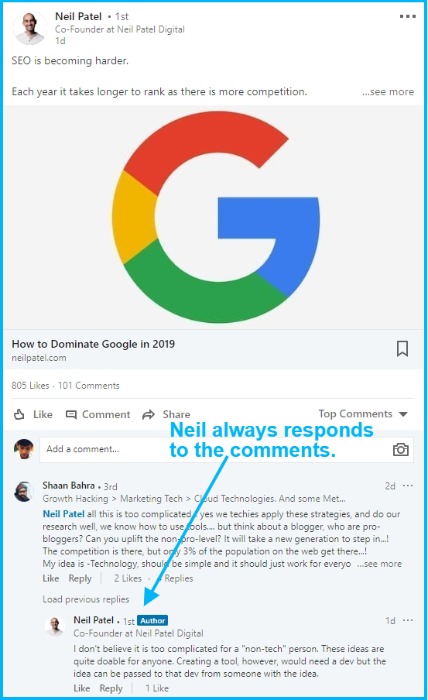
The engagement doesn’t mean replying to the comments on your blog only. If your followers are tweeting about your website or content, hop on and talk to them. If they’re discussing the issues, try helping them out. If they’re admiring your product or service, be thankful and ask them how you can help them further.
There are so many companies who take engagement with the audience very seriously. Buffer has been quite amazing with following-up on the social media. If you reach out to them via Twitter, you’re likely to get a response from them.
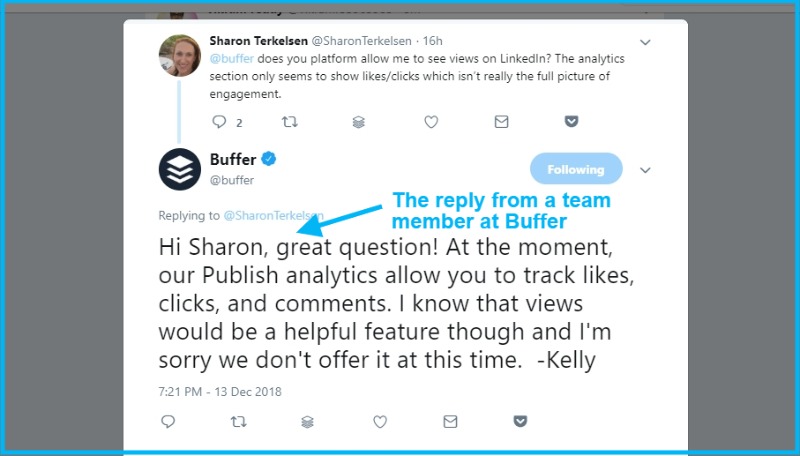
So it shows that companies which have successfully done content marketing knew that engagement would help them grew their relationships with the audience. Thus, it’d help them convert some of the visitors into paying customers over time.
- Product Placement in the Content
What I like about blogging is that we can have conversations, share experiences, and tell stories through our content. Additionally, we can naturally inject our own ideas, suggestions, achievements, and products in the content to put them out there. It becomes a whole lot easier for the audience to digest the small bits of information about the products while reading the topics they’re essentially interested in.
The beauty of content marketing is that it requires you to put out content that delivers value so that people could get attracted to your platform or brand for further engagement. If you aren’t providing enough value, the readers are likely to slip away and might not come back soon.
There is a thin line between aggressive promotion and highlighting the product where necessary. To understand that what could hurt the user experience of your visitor and what could not, you should pay attention to this: if you keep infusing your products or the products you’re promoting through your blog, the audience would end up frustrated at some point. The whole point of their visit is to learn something from you or to find a solution to their problem.
You might have seen blogs which have multiple popups, optins, ads – everything is happening at the same time. Most readers jump off right away. So you have to be careful with such things.
It doesn’t mean you don’t have to mention your product in your content. There has to be a balance in it. Always tell about your product in the content where it’s necessary. I recently came across an article on Gumroad; I didn’t know about their app library before. They mentioned their app library where it was required. Take a look at the example from Gumroad:
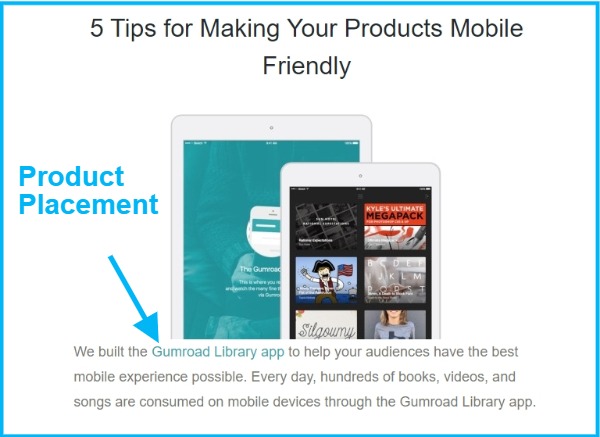
We often mention ContentStudio in our content, especially where we feel that readers must know about it.

Even though the essence of content marketing is educating and helping the audience, but if the content isn’t converting the audience into paying customers at all, then there is something that needs to be fixed. The reason is that the product placement is an integral part of the content strategy of any brand.
When a company produces content whether it’s article, podcast, or video, it puts money, energy, and time into producing and putting out that content. So there is nothing wrong with optimizing the content for the better. Blogging provides an opportunity for companies to talk about their products from time to time. Some bloggers and companies spoil their chance to convert the visitors into paying customers by shifting their focus from helping the audience towards making money. And, that’s how they lose down the road.
- Outbound Linking to the Influencers
It should have been clear by now that content marketing is not just about creating and publishing content of any type, but instead, it’s a process of building relationships, delivering help, and sharing things you know through your platform.
When we create any type of content, especially written content, we often mention companies and influencers that are related to the topic. If you haven’t been doing this, you’re doing it wrong. What it does for you is unbelievable. Here are two benefits of mentioning influencers in your content:
- It builds a relationship with the influencers
When you highlight someone in your content with a good intention such as helping out your audience, chances are, the influencer would find out about it. It helps you build a relationship with them, especially if you constantly highlighting them in your content. The reason is that you’re promoting them without even asking for anything in return, and it matters a lot.
- Readers find the resources helpful
The fundamental reason for linking out to any influencer or brand is that it helps us convey the message properly. The audience takes it very well because they benefit off of the resources that we share in our content. Not only does it build the trust of the audience, but it also converts them into loyal fans.
There are tons of examples of linking out to the influencers if you consume content on a regular basis. The reason outbound linking is being discussed here is that blogging allows us to make it happen effectively. Sure, you can mention an influencer in your video or infographic, they’d notice when someone would forward it to them or they’d stumble upon your piece of content somehow.
On the other hand, blogging works a little differently in this regard. Influencers, pro-bloggers, and companies use SEO softwares to track their keywords, content performance, and search engine rankings. A lot of SEO softwares inform the users about the websites and blogs that have mentioned their sites or pages; you might have heard about the term “backlink” in the content creation and SEO discussions – that’s what happens when someone links out to us. Apparently, the more sites link to us, the better our website’s SEO position becomes. However, it’s a whole different topic that how and what type of backlinks work well.
The point is that blogging does help us in developing outreach. It allows us to connect with the influencers on a deeper level than an average reader.
Hubspot often mentions influencers from the marketing and entrepreneurship backgrounds in their content. Take a look at the snippet from their blog post:

Shopify also knows the importance of outbound links; they also mention brands and influencers every now and then. I recently came across an article on their blog and saw a mention:

Similarly, we at ContentStudio don’t hesitate to link out to the websites, blogs, and influencers on our ContentStudio’s blog. The reason is the same; it helps us spread the word as well as it educates the masses.

Therefore, it’s obvious that being noticed by the top brands in your niche or the influencers who have been dominating the space would cash out at some point. But don’t overdo when it comes to linking out to the people or brands. Instead, try to add value to the content by doing whatever it takes.
Takeaway
I thoroughly went through different reasons why blogging is essential to our content marketing strategy. The core point of this topic is that there are top brands in the world of marketing that are still utilizing blogging as their attention-seeking tool. They might not be converting all the visitors into the paying customers instantaneously, but they’d definitely be building a tribe of loyal readers – over time, it would make a lot of difference.
Sure, you’d hear that Facebook ads are a better way to sell your product, but you won’t hear that a brand built a connection with the audience through an ad. The difference is in the intent; we run a Facebook ad to sell a product at an occasion, and we start content marketing to gain attention, deliver value, and build a loyal fan base so that we could nurture them for the future. I’m not arguing that which one is better nor I think you should just pick one of them. All I want to say is that blogging is a backbone of content marketing.
The importance of blogging can’t be denied even when the technology is rapidly changing – as of now we can do voice search rather than typing in our search term. Again, blogging comes into play here. The way you put out content would affect your brand’s positioning in the search engines.
So the fact of the matter is that one can’t write-off blogging from content marketing. The power of words is still very much relevant.
What do you think about the relevance of blogging in today’s content marketing?

Leave a Reply